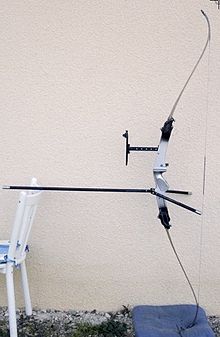Stabilizer (archery)
A stabilizer ( Engl . "Stabilizer"), even stabilization is the archery a technical sheet features , the vibrations in the arrow dampens -Abschuss.
Use and function of the stabilizer
When the arrow is fired, the muscle power stored in the limbs of the bow is suddenly released via the bowstring to the arrow. The subsequent return causes the limbs to relieve themselves and in turn have a force in the direction of the future arrow flight. The tendon swings back to its original position and excess energy is transferred through the limbs into the middle part of the bow. This leads to the so-called hand shock, because the bow transfers the vibrations directly to the bow hand.
In this situation, twisting of the bow arm occurs, depending on the magnitude of the shock transmitted to the hand. If mistakes were made when loosening the arrow, they are also transferred here. This hand shock can be very strong, so that under certain circumstances a bow could hardly be controlled. The hand shock can lead to rotations that counteract accurate arrow flight and are therefore a significant source of errors in archery.
A stabilizer dampens this energy in a rubber buffer. The additional weight delays the turning effect during launch. A stabilizer, for example, creates a calmer posture and a smoother shot sequence and allows more precise shooting. The stabilizer is screwed on to the central part of the arch at a point provided for it.
Construction
Basically, a stabilizer consists of a long rod with its weight at the tip. A monostabilizer is attached to the front of the bow and protrudes forward in the direction of fire. The counterpart is a counter stabilizer, which is used for horizontal stabilization. Further stabilizers can be attached to the side in a V-shape.
If a stabilizer may be attached to a bow, there are no specific technical specifications in archery rules for the construction of this part, but no electrical parts may be used.
literature
- Ekkehard Höhn, Karl-Heinz Hörnig: Traditional tuning, fine-tuning of longbows and recurve. Hörnig, 2000, ISBN 3-9805877-1-1
- Oliver Haidn, Jürgen Weineck, Veronika Haidn-Tschalova: Optimal archery - training and movement science basics . Spitta Verlag, 2010, ISBN 978-3-938509-74-6
- Johann Krost: Archery from 0 to 1300. Self-published, 2005, ISBN 978-3-00000024-9
- John C. Williams: Textbook of Archery. Weinmann, 2010, ISBN 978-3-87892050-2
Web links
- How the stabilizer works (private website)
